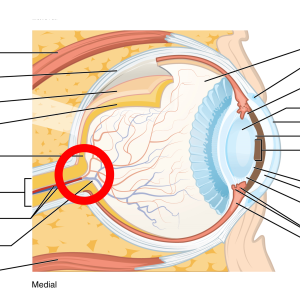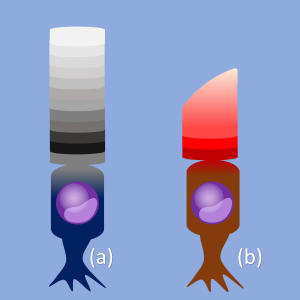Light and Eyeballs
83
Learning Objectives
Be able to describe the different layers and cell types in a retina.
Know what the differences are between rods and cones.
The retina is composed of several layers and contains specialized cells for the initial processing of visual stimuli. The photoreceptors (rods and cones) change their membrane potential when stimulated by light energy. The change in membrane potential alters the amount of neurotransmitter that the photoreceptor cells release onto bipolar cells in the outer synaptic layer. It is the bipolar cell in the retina that connects a photoreceptor to a retinal ganglion cell (RGC) in the inner synaptic layer. There, amacrine cells additionally contribute to retinal processing before an action potential is produced by the RGC. The axons of RGCs, which lie at the innermost layer of the retina, collect at the optic disc and leave the eye as the optic nerve (Fig.8.5.1). Because these axons pass through the retina, there are no photoreceptors at the very back of the eye, where the optic nerve begins. This creates a “blind spot” in the retina and a corresponding blind spot in our visual field.

The retinal surface includes two types of photoreceptors called rods and cones, based on their shape (Fig.8.5.2) Rods are very sensitive to light and serve as the basis for vision in the dark, however visual acuity is poor in comparison to during daylight. Since rods are monochromatic (i.e., respond to only one color) and the information cannot be combined with information from cone receptors, very limited color perception is possible in the dark. There are three types of cones activated during daylight, each enabling perception of color on limited sections of the visible part of the electromagnetic spectrum: those responding to short (bluish), medium (greenish), and long (reddish) wavelengths.

The outer segments of the rods and cones are mixed together to tessellate the back half of the eyeball and catch light from everywhere, with two exceptions. In the fovea, there are only cones. In the blind spot, there are no photoreceptors because all of the axons are leaving the eye.
OpenStax, Anatomy and Physiology Chapter 14.1 Sensory Perception
Provided by: Rice University.
Access for free at https://openstax.org/books/anatomy-and-physiology/pages/14-1-sensory-perception
License: CC-BY 4.0
Adapted by: Kathryn TaterkaPsychology by Jeffrey C. Levy, Vision
Provided by: B.C. Faculty Pressbooks
URL: https://pressbooks.bccampus.ca/thescienceofhumanpotential/chapter/vision/
License: CC BY 4.0
Adapted by: Kathryn Taterka

